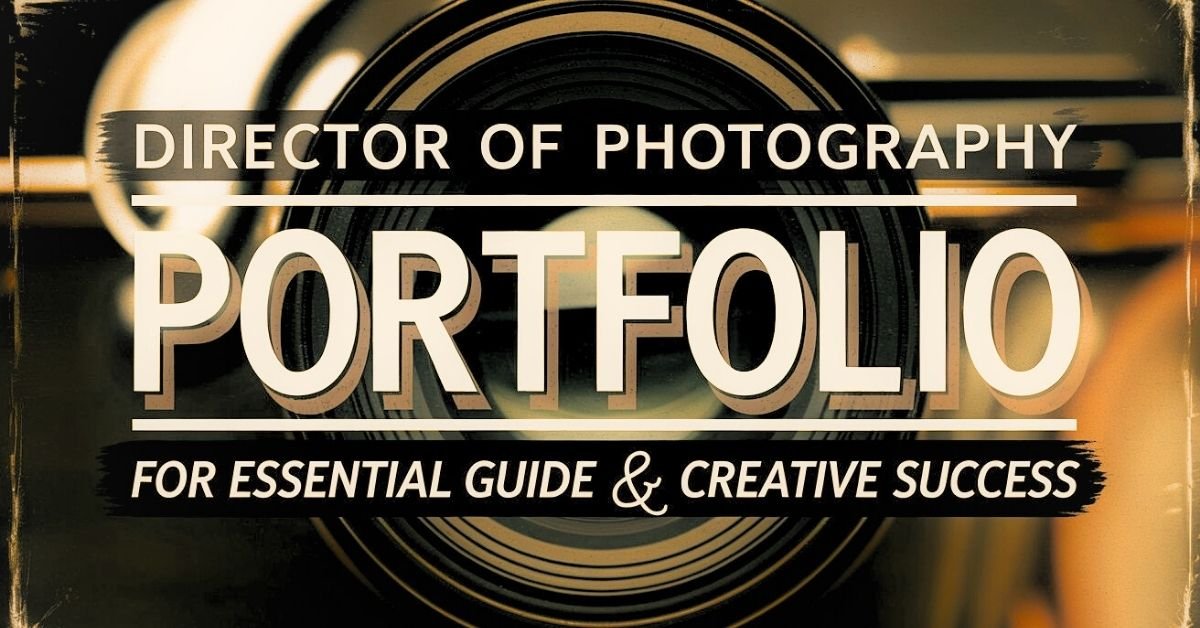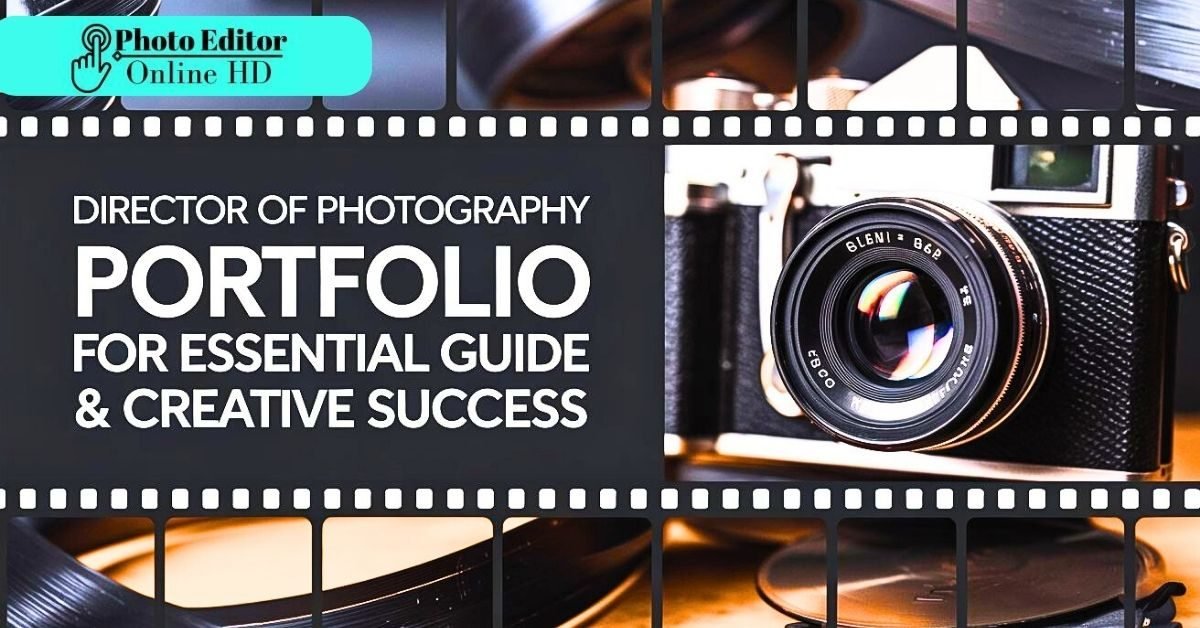A director of photography portfolio is a visual resume that showcases the unique skills, style, and expertise of a cinematographer or videographer. Whether you’re an aspiring director of photography (DP) or a seasoned professional looking to update your portfolio, crafting a compelling collection of your work is essential for standing out in the competitive film and video production industry. In this guide, we’ll explore everything you need to know about creating a successful portfolio that highlights your artistic vision and attracts potential clients or collaborators.

Why You Need a Director of Photography Portfolio:
As a director of photography, your portfolio serves as the first impression you give to producers, directors, and agencies. It is the primary tool for demonstrating your capability, versatility, and creativity. Here are some key reasons why having a well-organized and high-quality portfolio is vital:
- Showcases Your Skills: Your portfolio highlights your technical ability, such as lighting, camera work, and composition. It visually communicates what words cannot.
- Builds Credibility: A polished portfolio acts as proof of your experience. It shows potential clients or employers that you’ve successfully worked on projects and delivered results.
- Gains Exposure: Sharing your portfolio on social media, websites, and networking platforms can help get your name and work in front of the right people in the industry.
- Differentiates You from Competitors: A unique, well-structured portfolio can set you apart from other DPs and leave a lasting impression on potential collaborators.
How to Create a Winning Director of Photography Portfolio:
Creating a portfolio that captures attention requires a thoughtful and strategic approach. Here’s a step-by-step guide to building a standout portfolio:
1. Select Your Best Work
It’s tempting to include every project you’ve ever worked on, but quality should always trump quantity. Choose a selection of your strongest and most relevant projects that demonstrate your range and depth. Keep these tips in mind:
- Diverse Projects: Include a variety of genres, formats, and styles to showcase your versatility.
- Consistency: Ensure that all the work in your portfolio reflects your current skill level and artistic vision.
- Relevance: Tailor your portfolio to the type of work you want to attract. If you’re aiming for commercial projects, feature more corporate or advertising shoots.
2. Organize with a Clear Structure
A well-organized portfolio is easier for potential clients to navigate and leaves a professional impression. Consider these organizational elements:
- Introduction Page: Start with a brief bio or introduction about your approach, style, and experience.
- Categories: Divide your work into categories like commercials, narrative films, music videos, or documentaries, depending on what you specialize in.
- Project Details: For each project, provide context by briefly describing your role, the challenge of the project, and how you solved it creatively.
- Demo Reel: Include a short demo reel that provides an overview of your best clips, giving a quick snapshot of your abilities.
3. Highlight Your Visual Style
The visual style is at the core of what you offer as a DP. Your portfolio should be an extension of your creative identity. Here’s how to make sure your personal style shines:
- Lighting: Whether you prefer natural light, dramatic contrasts, or bright and airy tones, show off your mastery of lighting techniques.
- Composition: Highlight how you use framing, camera angles, and movement to tell a story visually.
- Color Grading: Include projects that demonstrate your approach to color. Are you inclined towards vibrant hues, muted tones, or monochromatic palettes?
4. Make It User-Friendly
When potential clients or collaborators visit your portfolio, they should be able to navigate it with ease. Whether it’s a physical book or a digital portfolio, ease of use is key:
- Mobile Responsiveness: If you have an online portfolio, ensure that it’s mobile-friendly. Many potential clients will view your work on their phones.
- Fast Loading: Make sure that your portfolio loads quickly, especially when showcasing high-quality video footage.
- Accessible Format: Consider offering both downloadable and online options. Some clients may prefer to look through a PDF, while others may want to browse on a website.
5. Update Your Portfolio Regularly
A stagnant portfolio can suggest that you’re not currently working or haven’t progressed in your craft. Regularly updating your portfolio with recent work keeps it fresh and shows that you’re constantly improving.
Elements of a Successful Director of Photography Portfolio:

A director of photography portfolio is more than just a collection of images and videos; it’s a narrative of your career. Here are the core elements that should be part of every successful portfolio:
Demo Reel
- A well-edited demo reel serves as a quick introduction to your work. Keep it concise, engaging, and representative of your strengths. A reel that’s too long or unfocused can lose the viewer’s attention. Aim for 1-2 minutes of your best, most impactful shots.
Project Breakdowns
- After showcasing your reel, offer project breakdowns that dive deeper into specific works. Describe the project’s goals, the creative approach you took, and the challenges you overcame during production. These breakdowns allow potential clients to understand your problem-solving abilities and creative process.
Client Testimonials
- If you’ve worked with notable clients or production companies, include their testimonials. Positive reviews and feedback from satisfied clients can significantly enhance your credibility.
Behind-the-Scenes Photos
- Adding behind-the-scenes photos can give potential clients insight into how you work on set. It showcases your leadership, teamwork, and communication skills—qualities that are just as important as your technical proficiency.
Where to Host Your Director of Photography Portfolio
Choosing the right platform for your portfolio is just as important as its content. Here are some popular platforms to consider:
1. Personal Website
Creating a personal website gives you full control over your portfolio’s design and layout. With website builders like WordPress, Squarespace, and Wix, you can create a professional and customizable site to showcase your work.
2. Vimeo or YouTube
Video hosting platforms like Vimeo and YouTube are ideal for DPs because they allow you to share high-quality footage while offering embed options for websites. Vimeo is often preferred for its higher video quality and more polished presentation.
3. Instagram
Instagram has become a powerful tool for filmmakers and directors of photography. It’s a great platform for sharing your best stills, short clips, and behind-the-scenes content. Instagram also allows you to reach a broad audience and engage directly with your followers.
SEO Tips for a Director of Photography Portfolio Website
If you’re hosting your portfolio on a website, it’s essential to optimize it for search engines. Here are some SEO tips to help your site rank higher:
1. Optimize Image and Video Files
Large image and video files can slow down your site, negatively affecting your search engine ranking. Compress files without sacrificing quality and use appropriate file names with relevant keywords.
2. Use Descriptive Titles and Meta Descriptions
Each page of your portfolio should have an optimized title and meta description. Incorporate relevant keywords, such as “cinematography” or “director of photography,” to increase the chances of appearing in search results.
3. Add Alt Text to Images
Search engines rely on alt text to understand what an image is about. Use descriptive alt text that includes keywords while accurately reflecting the image content.
4. Build Backlinks
Reach out to industry blogs, film websites, and professional communities to feature your work or link back to your portfolio. High-quality backlinks from credible sources can boost your SEO.
Taking Your Director of Photography Portfolio to the Next Level
Creating a powerful director of photography portfolio requires more than just gathering your best work. It’s about strategically presenting your skills, visual style, and versatility in a way that connects with your target audience. By selecting the right projects, maintaining a clean and organized structure, and optimizing for SEO, you can build a portfolio that not only showcases your talent but also attracts exciting new opportunities in the industry.
For further insights, explore resources like the American Society of Cinematographers or the British Society of Cinematographers for additional tips on elevating your craft and networking with industry professionals.
FAQs About Director of Photography Portfolio:
1. What should be included in a director of photography portfolio?
A portfolio should include a demo reel, high-quality samples of your best work, project breakdowns, client testimonials, and behind-the-scenes photos or footage. The portfolio should reflect your style, creativity, and technical skills in various cinematography formats, such as films, commercials, music videos, and documentaries.
—————————————————————————————————————————
2. How many projects should I feature in my portfolio?
It’s best to focus on quality over quantity. Include 5-10 of your strongest projects that demonstrate versatility and mastery of different genres. Ensure that each project showcases a unique aspect of your skills and expertise.
—————————————————————————————————————————
3. How long should my demo reel be?
A demo reel should typically be 1-2 minutes long. Keep it concise, ensuring every clip showcases your best work. The goal is to keep the viewer engaged while giving them a taste of your abilities in cinematography, lighting, and camera work.
—————————————————————————————————————————
4. How do I organize my director of photography portfolio?
Start with a brief bio and an introduction to your approach. Next, divide your work into categories like films, commercials, or music videos. Include context for each project, describing your role, challenges you faced, and how you executed the creative vision. Finally, conclude with a contact section or call to action for prospective clients.
—————————————————————————————————————————
5. What format should my portfolio be in?
A director of photography portfolio can be both digital and physical. A personal website is ideal for a digital portfolio, while you can also create a PDF or hard copy for in-person meetings. Many DPs also use platforms like Vimeo or YouTube to showcase their video work.
Photo Editor Online HD! Our powerful, web-based editing platform allows you to enhance, crop, and add unique effects to your photos with ease. Experience flexibility and control with our user-friendly interface, perfect for both beginners and professionals. With Photo Editor Online HD, you can transform your images into stunning visuals in no time. Explore our exciting features – from basic adjustments to advanced design tools like adding text, shapes, and icons. Plus, our free drawing tool lets you add that extra flair to your photos. Start creating amazing designs today with Photo Editor Online HD.









